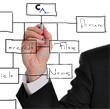
glidor@gmail.com
21068 Points
Joined January 2010
|
Originally posted by : HS Negi |
 |
US Sharmaji
I differ from your answer, How can we categorise the tools under the heard of Stores cosumable. Please backup ur answer with authority.
Mugundha : Nice question.
Regards
HS Negi |
 |
before going in Central Excise provisions, we have to take a short view of accounting system followed by the assessee, there are two provisions
1) take the tools "capitalized" and charge 15% depriciation under incometax act, and here i have some query that how the assessee treat the capital goods under their accounting system, coz the sale value can not be ttreated as scarap under incometax, but it should be similer to 85% ( for more than 180 days in put to use) or 92.5% ( for less than 180 days of use)
2) in industry there are two types of tools and impliments, a) which are of capital nature, which are run over the couple of years b) which are consumable nature, viz, hackshaw blaces , curtting tools, drill bits etc, which have life of few hours to few weeks maximum.
3) As the query is posted but its silent about its accounting of such tools under the incometax act, if they claim 100% depriciation on such items, how they can classify these under capital goods? or they are making random entry of short term capital loss under every tool purchase?
4) under CCR 2004, Rule 2, Definitions
|
(k)
|
"input" means-
|
|
|
(i)
|
all goods, except light diesel oil, high speed diesel oil and motor spirit, commonly known as petrol, used in or in relation to the manufacture of final products whether directly or indirectly and whether contained in the final product or not and includes lubricating oils, greases, cutting oils, coolants, accessories of the final products cleared along with the final product, goods used as paint, or as
packing material, or as fuel, or for generation of electricity or steam used in or in relation to manufacture of final products or for any other purpose, within the factory of production;
|
difinition of capital goods as per wikipedia
A capital good, or simply capital in economics, is a manufactured means of production.[1] Capital goods are acquired by a society by saving wealth which can be invested in the means of production.
Individuals, organizations and governments use capital goods in the production of other goods or commodities. Capital goods include factories, machinery, tools, equipment, and various buildings which are used to produce other products for consumption. Capital goods, then, are products which are not produced for immediate consumption; rather, they are objects that are used to produce other goods and services. These types of goods are important economic factors because they are key to developing a positive return from manufacturing other products and commodities.
Manufacturing companies also use capital goods. Capital goods help their company make functional goods to sell individuals valuable services. As a result, capital goods are sometimes referred to as producers’ goods or means of production. An important distinction should also be made between capital goods and consumer goods, which are products directly purchased by consumers for personal or household use.
For example, cars are generally considered consumer goods because they are usually bought by an individual for personal use. Dump trucks, however, are usually considered capital goods, because they are used by construction and manufacturing companies to haul various materials in order to make other products such as roads, bridges, dams, and buildings. Similarly, a chocolate candy bar is a consumer good but the machines used to produce the chocolate candy bar are considered capital goods.
Capital goods are generally man-made, and do not include natural resources such as land or minerals, or human capital—the intellectual and physical skills and labor provided by human workers.
The economic term 'capital goods' is not to be confused with the financial or accounting usage of 'capital', which may mean simply wealth or financial capital.
5) Now when the goods become part of balance sheet under fixed assets, it is called capital asset, but when the same is passed through P/L account without getting place in balance sheet, its to be treated as normal input used within production line.
i would request the query author to put a light of their accounting system maintained with such short lived capital assets and method of value reduction adopted by them for sale as scrap, under light of which we may continue the debate.




 CAclubindia
CAclubindia
